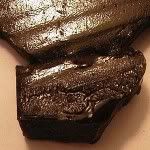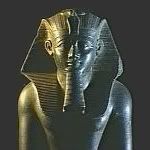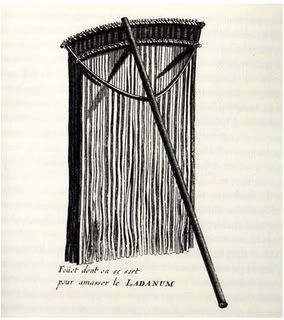Let's hear it from the man himself:
"Again, the most southerly country is Arabia; and Arabia is the only place that produces frankincense, myrrh, cassia, cinnamon and the gum called ledanon. All these, except myrrh, cause the Arabians a lot of trouble to collect. When they gather frankincense, they burn styrax (the gum which is brought into Greece by the Phoenicians) in order to raise a smoke to drive off the flying snakes; these snakes, the same which attempt to invade Egypt, are small in size and of various colors, and great umbers of them keep guard over the trees which bear the frankincense, and the only way to get rid of them is by smoking them out with storax. [...]
When the Arabians go out to collect cassia*, they cover their bodies and faces, all but their eyes, with ox-hides and other skins. The plant grows in a shallow lake, which together with the ground about it, is infested by winged creatures very like bats, which screech alarmingly and are very pugnacious. They have to be kept from attacking the men's eyes while they are cutting the cassia. [...]
The process of collecting cinnamon* is still more remarkable. Where it comes from, and what country produces it, they do not know; the best some of them can do is to make a fair guess that it grows somewhere in the region that Dionysus was brought ip.What they say is that the dry sticks, which we have learned from the Phoenicians to call cinnamon, are brought by large birds, which carry them to their nests, made of mud, on mountain precipices, which no man can climb, and that the method the Arabians have invented for getting hold of them is to cut up the bodies of dead oxen or donkeys, or dead animals into large joints, which they carry to the spot in question and leave on the ground near the nests. Then they retire to a safe distance and the birds fly down and carry off the joints of meat to their nests, which not bring strong enough to bear the weight, break and fall to the ground. Then the men come along and pick up the cinnamon, which is subsequently exported to other countries. [...]
Still more surprising is the way to get ledanon -or ladanum, as the Arabians call it. Sweet-smelling substance thought it is, it is found in a most malodorous place; sticking, namely, like glue in the beards of he-goats who have been browsing in the bushes. It is used as an ingredient in many kinds of perfume, and is what the Arabians chiefly burn as incense. So much for perfumes; let me only add that the whole country exhales an odor marvelously sweet. "
~Herodotus, The Histories, book III. (Translation in English by Aubrey de Selincourt)
*Cassia and cinnamon come from the same tree, the only difference being that cinnamon is properly the branch with the bark on, whereas cassia is the bark without the branch. Ever since the former ceased to be traded, the latter has usurped the name, therefore "our" cinnamon is the cassia of the ancients. Pliny's description of the cassia agrees with the real cinnamon. (Therefore the "cinnamon" mentioned by Herodotys if not altogether a fable should be the calamus, or aromatic reed, mentioned by Diodorus and in Exodus.) The Phoenician word was probably identical with the Hebrew, cinamom, hence the Greek κινάμμωμον, and the Latin 'cinnamum'.
Samuel Bochart [Geographia Sacra seu Phaleg et Canaan (Caen 1646) II.iii] observes that all Greek names of spices are of Semitic origin. As the Phoenicians imported all those spices into Greece they would naturally be known to the Greeks by their Phoenician names.
.jpg)









